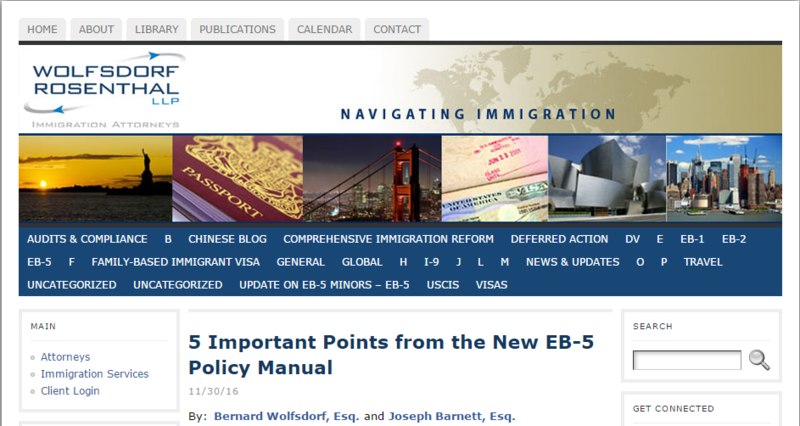
Today, USCIS released an important draft version of the USCIS Policy Manual on the employment-based fifth preference immigrant visa category (EB-5).
Once finalized, the guidance contained in the Policy Manual will be controlling and will supersede any related prior USCIS guidance. USCIS has combined previous adjudication memoranda and current adjudication policy in one source.
Here are five important points from the new EB-5 Policy Manual:
- Investment of Capital. The Policy Manual includes clarifications over the type of type of “capital” which can be invested in a new commercial enterprise. It states that an immigrant investor using loan proceeds as capital (most commonly, a home equity loan) to be, under the terms of the loan agreement, personally and primarily liable for the indebtedness secured by assets owned by the immigrant investor. Additionally, a loan secured by an immigrant investor’s assets only qualifies as capital up to the fair market value of the pledged assets. The Policy Manual also provides requirements for using a promissory note (a promise to pay) as capital, including a requirement for the promissory note debt to have been properly perfected in accordance with local laws and fully amenable to seizure by a U.S. noteholder.
- Return on Investment and Redemption Agreements. An immigrant investor may receive a return on his or her capital in the form of a distribution of profits from the new commercial enterprise, even during the conditional residency period and before creation of jobs, as long as the distribution is not a portion of the investor’s minimum qualifying investment or is guaranteed to the investor. For immigrant investors who contributed capital in exchange for an equity interest, there can be no redemption agreement which authorizes the immigrant investor to demand a return of some portion of the investment funds, even after obtaining conditional permanent resident status.
- Targeted Employment Areas. A geographic area that once qualified as a Targeted Employment Area (TEA) may no longer qualify, as employment rates or population can increase over time. An immigrant investor cannot rely on previous TEA determinations that were made based on facts that have subsequently changed. The appropriate date for USCIS to determine whether an immigrant investor’s investment qualifies for the lower capital investment amount depends on the time of the investment: If the investment of capital is made to the new commercial enterprise (or made available to job-creating entity in regional center context), the analysis focuses on whether the area qualifies as a TEA at time of the investment. If the investment of capital has not been made at the time of I-526 filing, the analysis focuses on whether the area qualifies as a TEA at time of the I-526 filing. Additionally, an immigrant investor is not required to demonstrate that the area in question remains a TEA at the time the Form I-829 removal of conditions application is filed.
- Material Change. The Policy Manual provides some clarification (though also raises more questions) about the difficult concept of “material change.” It states that changes that occur after a Form I-526 filing but before an immigrant investor obtains conditional permanent resident status are considered material if they result in the investor’s ineligibility. This appears too vague and could be interpreted to mean leniency for minor changes that occur after filing but before approval of the conditional green card. The May 30th 2013 guidance memo is rigid on changes occurring prior to issuance of conditional permanent residence, but somewhat more lenient on changes that occur after approval of conditional permanent residence. This is important especially for Chinese waiting in the quota line who can get approval of their petitions but must wait for their place in line before they can obtain conditional permanent residence.
- I-829 Adjudications. USCIS is proposing that applications to remove the conditional permanent residents filed on Form I-829 include the comprehensive business plan and economic analysis previously submitted with the Form I-526. USCIS clarifies that the jobs need not be in existence of the time of I-829 adjudication to be credited, as long as they were created because of the immigrant’s investment and such jobs were considered permanent when created.
Wolfsdorf Rosenthal’s EB-5 team will provide further updates on this important adjudication guidance.
http://connect.wolfsdorf.com/?p=2518
Mentions
Securities Disclaimer
This website is for informational purposes only and does not constitute an offer or solicitation to sell shares or securities. Any such offer or solicitation will be made only by means of an investment's confidential Offering Memorandum and in accordance with the terms of all applicable securities and other laws. This website does not constitute or form part of, and should not be construed as, any offer for sale or subscription of, or any invitation to offer to buy or subscribe for, any securities, nor should it or any part of it form the basis of, or be relied on in any connection with, any contract or commitment whatsoever. EB5Projects.com LLC and its affiliates expressly disclaim any and all responsibility for any direct or consequential loss or damage of any kind whatsoever arising directly or indirectly from: (i) reliance on any information contained in the website, (ii) any error, omission or inaccuracy in any such information or (iii) any action resulting therefrom.




